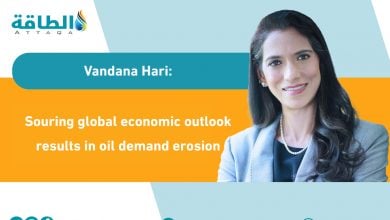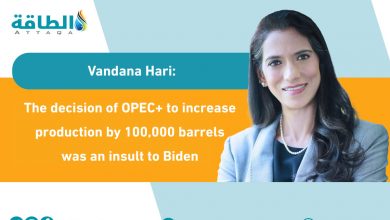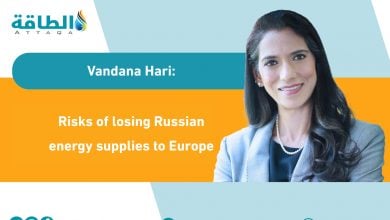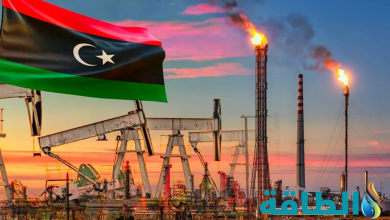OPEC+ is expected to consider keeping production unchanged for September (Article)
Vandana Hari

The financial markets have just been through a particularly turbulent week, with the US Federal Reserve’s interest rate decision on Wednesday and the US’ second-quarter GDP data on Thursday keeping investors on the edge of their seats. Crude was dragged along for the roller-coaster ride in sentiment.
The net impact of the two big events – and one that wasn’t diluted by any other unforeseen developments – was a sense of relief.
Announcing a rate hike of 75 basis points as expected, Fed Chairman Jerome Powell said interest rates had reached a “neutral level”, a jargon to mean that monetary policy was now neither accommodative nor restrictive. The term is used to describe interest rates that are consistent with full employment and price stability.
The US Q2 GDP coming in at a worse-than-expected 0.9% contraction (following a drop of 1.6% in Q1), bolstered expectations that the Fed would need to slow down its pace of interest rate increases.
That was a positive for the stock markets and as it turned out, also for crude, which continued to be led by the risk appetite in the broader financial markets.
RELIEF RALLY TRIGGERS BULLISH BIAS
There were a couple of bearish developments on the fundamentals front in oil, but they were mostly ignored. As crude was swept up in the relief rally of the financial markets, there was an attention bias towards events that supported the bullish narrative.
The 590,000 b/d Keystone pipeline from Canada to the US resumed full operations over the July 23-24 weekend after flows were reduced by 15% for nearly a week due to a fire at a transformer in South Dakota.
Libyan crude output was back full-tilt at 1.1 million b/d, almost double the June levels, after the government in Tripoli forged agreements with protesters who had been blockading oil facilities for several weeks. Libyan crude exports also returned to normal.

However, the US Energy Information Administration’s report, showing substantial draws in domestic crude and gasoline inventories in the week to July 22, a sharp reversal from the trend of the two prior weeks, helped fuel crude’s rally mid-week.
Oil bulls cheered EIA data showing US gasoline consumption jumping from 8.5 million b/d in the week to July 15 to 9.2 million b/d in the week to July 22. Some market participants pointed to a drop in gasoline prices at the pump from the all-time highs of mid-June as supportive of demand going forward.
But it remains to be seen whether the US gasoline demand recovery sustains; we prefer to avoid the noise inherent in weekly EIA data to look at four-week averages, instead. Gasoline consumption on a four-week average basis was 8.8 million b/d, a substantial 7% lower than the same period of 2021.
US distillate demand trajectory remains flat, running about 1% below year-ago levels at 3.8 million b/d on a four-week average basis.
We would keep a close watch on US consumer confidence and retail spending. The country’s job market has shown a healthy recovery so far, but a clutch of tech companies have announced plans to lay off staff or put a freeze on hiring. As rising interest rates pressure corporate profits, Americans may begin to despair over their job and career prospects and tighten their purse strings.
US consumer confidence dropped to a one-and-a-half-year low in July. Consumer spending inched up by a mere 0.1% in June, the latest data showed on Friday, following a drop of 0.3% in May and underscoring how decades-high inflation is tempering demand.
CHINA PUTS ZERO-COVID OVER GROWTH
Over in China, a meeting of the Politburo, the Communist Party’s top decision-making body, concluded that the country should achieve the “best outcome possible” for economic growth this year, while sticking to a strict Zero-Covid policy, providing leeway for missing the 5.5% GDP target set for 2022.
No new stimulus policies were announced at the meeting, which was chaired by President Xi Jinping.
Meanwhile, rolling lockdowns and other Covid restrictions continue to dampen economic activity and travel across the country, as the more contagious BA. 5 variant of the coronavirus has been spreading rapidly.
Nearly 260 million people or roughly a fifth of the Chinese population were under full or partial lockdown as per the Japanese bank Nomura’s estimates at the start of last week.
OPEC+ LIKELY TO REMAIN CONSERVATIVE
As the OPEC/non-OPEC energy ministers’ meeting on August 3 to decide September production policy comes into focus, but the market is not expecting any major change in course.
The producers’ group will have fully unwound its unprecedented output cuts in August, in theory freeing member countries of production restrictions. But OPEC+ is expected to consider keeping production unchanged for September, or maybe discuss a modest hike, according to a Reuters report.
We expect a cautious and conservative approach to restoring production, a course set by the de facto leader Saudi Arabia since the start of 2021, to prevail, especially with new demand uncertainties appearing on the horizon amid a global economic downturn.
OPEC+ missed its June production target by about 2.74 million b/d, according to consensus estimates of independent surveys. This gap could narrow, but only marginally, if Saudi Arabia and the UAE increase supply in the last four months of the year and if Russia continues to be able to redirect increasing volumes of crude and refined products to markets outside the G7 and Europe.
Vandana Hari is Founder and CEO of Vanda Insights, which provides macro-analysis of the global oil markets.
READ MORE..
- Deceptive Solutions for Fossil Fuel Dependence Drive Prices Higher (Article)
- Deceptive Solutions for Fossil Fuel Dependence Drive Prices Higher (Article)
- The Biden Administration’s policies have pushed gasoline prices higher (Article)
- (Article) The Top 5 Reasons Behind Fruitless Energy Policies
- The Biden Administration’s policies have pushed gasoline prices higher (Article)









